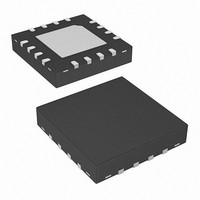ISL6520AIRZ-TS2698 Intersil, ISL6520AIRZ-TS2698 Datasheet - Page 9

ISL6520AIRZ-TS2698
Manufacturer Part Number
ISL6520AIRZ-TS2698
Description
IC CTRLR PWM SYNC BUCK 16-QFN
Manufacturer
Intersil
Datasheet
1.ISL6520ACBZ.pdf
(12 pages)
Specifications of ISL6520AIRZ-TS2698
Pwm Type
Voltage Mode
Number Of Outputs
1
Frequency - Max
340kHz
Duty Cycle
100%
Voltage - Supply
4.5 V ~ 5.5 V
Buck
Yes
Boost
No
Flyback
No
Inverting
No
Doubler
No
Divider
No
Cuk
No
Isolated
No
Operating Temperature
-40°C ~ 85°C
Package / Case
16-VQFN Exposed Pad, 16-HVQFN, 16-SQFN, 16-DHVQFN
Frequency-max
340kHz
Lead Free Status / RoHS Status
Lead free / RoHS Compliant
The response time to a transient is different for the
application of load and the removal of load. The following
equations give the approximate response time interval for
application and removal of a transient load:
where: I
response time to the application of load, and t
response time to the removal of load. The worst case
response time can be either at the application or removal of
load. Be sure to check both of these equations at the
minimum and maximum output levels for the worst case
response time.
Input Capacitor Selection
Use a mix of input bypass capacitors to control the voltage
overshoot across the MOSFETs. Use small ceramic
capacitors for high frequency decoupling and bulk capacitors
to supply the current needed each time Q
small ceramic capacitors physically close to the MOSFETs
and between the drain of Q
The important parameters for the bulk input capacitor are the
voltage rating and the RMS current rating. For reliable
operation, select the bulk capacitor with voltage and current
ratings above the maximum input voltage and largest RMS
current required by the circuit. The capacitor voltage rating
should be at least 1.25 times greater than the maximum
input voltage and a voltage rating of 1.5 times is a
conservative guideline. The RMS current rating requirement
for the input capacitor of a buck regulator is approximately
1/2 the DC load current.
For a through hole design, several electrolytic capacitors may
be needed. For surface mount designs, solid tantalum
capacitors can be used, but caution must be exercised with
regard to the capacitor surge currentrating. These capacitors
must be capable of handling the surge-current at power-up.
Some capacitor series available from reputable manufacturers
are surge current tested.
MOSFET Selection/Considerations
The ISL6520A requires 2 N-Channel power MOSFETs. These
should be selected based upon r
requirements, and thermal management requirements.
In high-current applications, the MOSFET power dissipation,
package selection and heatsink are the dominant design
factors. The power dissipation includes two loss components;
conduction loss and switching loss. The conduction losses are
the largest component of power dissipation for both the upper
and the lower MOSFETs. These losses are distributed between
the two MOSFETs according to duty factor. The switching
losses seen when sourcing current will be different from the
switching losses seen when sinking current. When sourcing
current, the upper MOSFET realizes most of the switching
t
RISE
=
TRAN
V
L x I
IN
- V
is the transient load current step, t
TRAN
OUT
1
and the source of Q
t
FALL
9
DS(ON)
=
L x I
, gate supply
V
1
OUT
TRAN
turns on. Place the
FALL
2
RISE
.
is the
is the
(EQ. 7)
ISL6520A
losses. The lower switch realizes most of the switching
losses when the converter is sinking current (see the
following equations ). These equations assume linear voltage-
current transitions and do not adequately model power loss
due the reverse-recovery of the upper and lower MOSFET’s
body diode. The gate-charge losses are dissipated by the
ISL6520A and don't heat the MOSFETs. However, large gate-
charge increases the switching interval, t
the MOSFET switching losses. Ensure that both MOSFETs
are within their maximum junction temperature at high ambient
temperature by calculating the temperature rise according to
package thermal-resistance specifications. A separate heatsink
may be necessary depending upon MOSFET power, package
type, ambient temperature and air flow.
Given the reduced available gate bias voltage (5V),
logic-level or sub-logic-level transistors should be used for
both N-MOSFETs. Caution should be exercised with devices
exhibiting very low V
through protection present aboard the ISL6520A may be
circumvented by these MOSFETs if they have large parasitic
impedences and/or capacitances that would inhibit the gate
of the MOSFET from being discharged below it’s threshold
level before the complementary MOSFET is turned on.
Figure 7 shows the upper gate drive (BOOT pin) supplied by a
bootstrap circuit from V
develops a floating supply voltage referenced to the PHASE
pin. The supply is refreshed to a voltage of V
diode drop (V
Losses while Sinking Current
Losses while Sourcing Current
P
P
P
P
+
-
UPPER
LOWER
ISL6520A
LOWER
UPPER
Where: D is the duty cycle = V
+5V
VCC
FIGURE 7. UPPER GATE DRIVE BOOTSTRAP
= Io
= Io
=
=
t
F
D
SW
Io
S
Io
2
) each time the lower MOSFET, Q
2
2
is the switching frequency.
2
x r
x r
is the combined switch ON and OFF time, and
×
+ V
×
GND
D
DS(ON)
DS(ON)
r
BOOT
r
DS ON
BOOT
UGATE
PHASE
LGATE
D
DS ON
GS(ON)
-
CC
(
(
. The boot capacitor, C
x D
x (1 - D)
)
)
×
×
C
D
characteristics. The shoot-
BOOT
(
1 D
+
–
1
-- - Io
2
OUT
⋅
)
Q1
Q2
+5V
+
/ V
×
1
-- - Io
2
SW
V
⋅
IN
IN
,
×
which increases
×
CC
V
t
NOTE:
V
SW
NOTE:
V
IN
G-S
G-S
December 10, 2009
BOOT
less the boot
×
2
×
≈
, turns on.
t
≈
F
SW
V
S
V
CC
,
CC
FN9016.6
×
(EQ. 8)
F
-V
S
D













